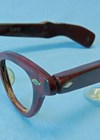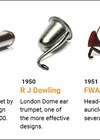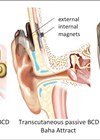Over a century of progress in hearing aid technology has transformed the lives of those with hearing impairments. From the bulky, conspicuous devices of the past, to today’s sleek, AI-powered solutions, this article explores the three key eras of development.
In the years since the first hearing aids became commercially available in 1902, the most conspicuous development is their size [1]. But in fact, everything else has changed too, e.g. technology, performance, design, and applicability.
The development of hearing aids through the past century can be divided into three eras: miniaturisation, fighting the side effects, and focus on the audiological needs of the user. In this short paper, we will have a brief look at each of these eras. We will look at the major technological achievements and what difference they have meant to people with hearing impairment.
Miniaturisation
In the early technical development of hearing aids, there was focus on their appearance and especially on their size. The biggest challenge in reducing their size was the size of the components which needed to fit into the cabinet of the hearing aid. Also, since most people wore black clothes 100 years ago, most hearing aids were black, simply to better blend in with the clothing.
When the bone conductor was invented in 1932 by Hugo Lieber, this technology was soon applied to hearing aids. The bone conductor was placed on the mastoid behind the ear instead of normal earphones which were placed on the ear and, thus, less conspicuous. “The earpiece was the size of an ordinary alarm clock and black as tar. Miles away in 1920 I was known as the man with the black bucket on his head.” This quote is by a Danish author who was a lifetime hearing aid user.
In 1953, when the transistor became available for the hearing aid industry, the size of the body-worn hearing aids could finally become decreased significantly. Most of the hearing aid styles we know today were developed in the 1950s. Later, in the mid-1980s, small hearing aids were developed to fit entirely into the ear canal which, in practice, made them invisible. “As a teenager I tried everything. Being long-haired and hiding it. It bothered me a bit as a teenager. But then… the first couple of tries were behind-the-ear instruments. Then it became in-the-canal instruments. At the time I got these for the first time, the ones that go all into the ear canal, off went the hair.” A quote from a 58-year-old male (see Figure 1).

Figure 1. Illustration used as part of the marketing campaign for an in the canal hearing aid from 1987.
Instead of a beige hearing aid, the ear mould was gold plated to make it more desirable.
Fighting the side effects
Apart from the size of the hearing aids, and the users feeling stigmatised by wearing them, there were several other side effects of wearing hearing aids [2]. The so-called acoustic feedback was a huge problem. Acoustic feedback happens when the amplified sound in the ear canal is being picked up by the hearing aid microphone. This loop will result in a whistling from the hearing aid much like the acoustic feedback during live music performances. “It is often pointed out that the hearing aids are whistling (I can’t hear that myself). Wise people have told me that when the hearing aids are whistling, it is due to a non-sealing ear mould.” A quote from female user from 1985.
Previously, the only way to prevent whistling hearing aids was by ensuring a tight fit of the ear mould. The occlusion of the ear canal does unfortunately result in the voice of the hearing aid user being trapped in the ear canal. This is especially a problem for people with little or no hearing loss in the low frequencies. When the user speaks, the level of their own voice is higher than normal and the sound quality is hollow, muffled, and booming. “When I speak and hear my own voice, it feels like standing in a very large room”. Quote from 1995.
"The past decade of hearing aid development has focused on how we can better help the individual user overcome the problems of hearing in everyday life situations"
The only way to circumvent the problem with occlusion was by making a ventilation channel in the ear mould, but this would create acoustic feedback. It was not until 1990 that an acoustic feedback system was developed. The system was used to provide more amplification without feedback. In 1996, the first digital hearing aids came on the market. The digital technology enabled much more advanced sound processing, and new digital feedback suppression systems were developed. In the first systems, incoming sounds were analysed by the hearing aid and if they had a resemblance with the pattern of acoustic feedback, the sounds were attenuated. The first systems were not perfect. They would attenuate sounds of bells, birdsong and other whistling-like sounds. “I have a granddaughter who plays the violin. It works, but she also loves to whistle, and that causes discomfort and echoing sound in the hearing aids.” Quote from a male in 2008.
Using a mobile phone or a normal telephone was also a problem due to acoustic feedback, and the sound quality through a phone was not good. Around 2007, wireless connection between the hearing aids and a small device that was worn around the neck containing a Bluetooth connection enabled hands-free calls. Later, the low-energy Bluetooth connectivity was built directly into the hearing aids and could be connected to different devices like external microphones and TV streaming devices. These possibilities made a huge difference to the hearing aid users.
After a few years, these systems were perfected, and it was now possible to make hearing aid fittings with ventilation in the ear mould to remove the occlusion problems with own voice without causing feedback. Now the two most prominent side effects were gone [3].
Focus on the audiological needs of the user
With most of the side effects gone, the past decade of hearing aid development has focused on how we can better help the individual user overcome the problems of hearing in everyday life situations. At Oticon, research within the field of cognition leads to the concept of BrainHearing. BrainHearing is a way of looking at hearing as the complete auditory pathway, and providing the brain with all the acoustic information required such that the brain can make maximal use of (i.e. decode) the auditory information.In the latest generation of hearing aids, we make use of artificial intelligence. During the development of the hearing aid, a neural network has been trained with millions of different sound scenes to present the user with as clear a sound as possible. “In my previous hearing aids, I experienced that the sound was more wrapped in, while the sound in the new hearing aids is experienced as being unpacked, as if the sound spreads more over a larger frequency range. I like that”. Quote by female, 2022.
References
1. Berger KW. The Hearing Aid – Its operation and development. Third Edition. National Hearing Aid Society; 1984.
2. Kochkin S, Marketrak V. “Why my hearing aids are in the drawer”: The consumers’ perspective. The Hearing Journal 2000;53(2):34,36,39-41.
3. Nielsen C, Bollerup Henriksen T. 40 years of consumer comments: Making hearing aid feedback and occlusion past history. Hearing Review;2021:10-11.









